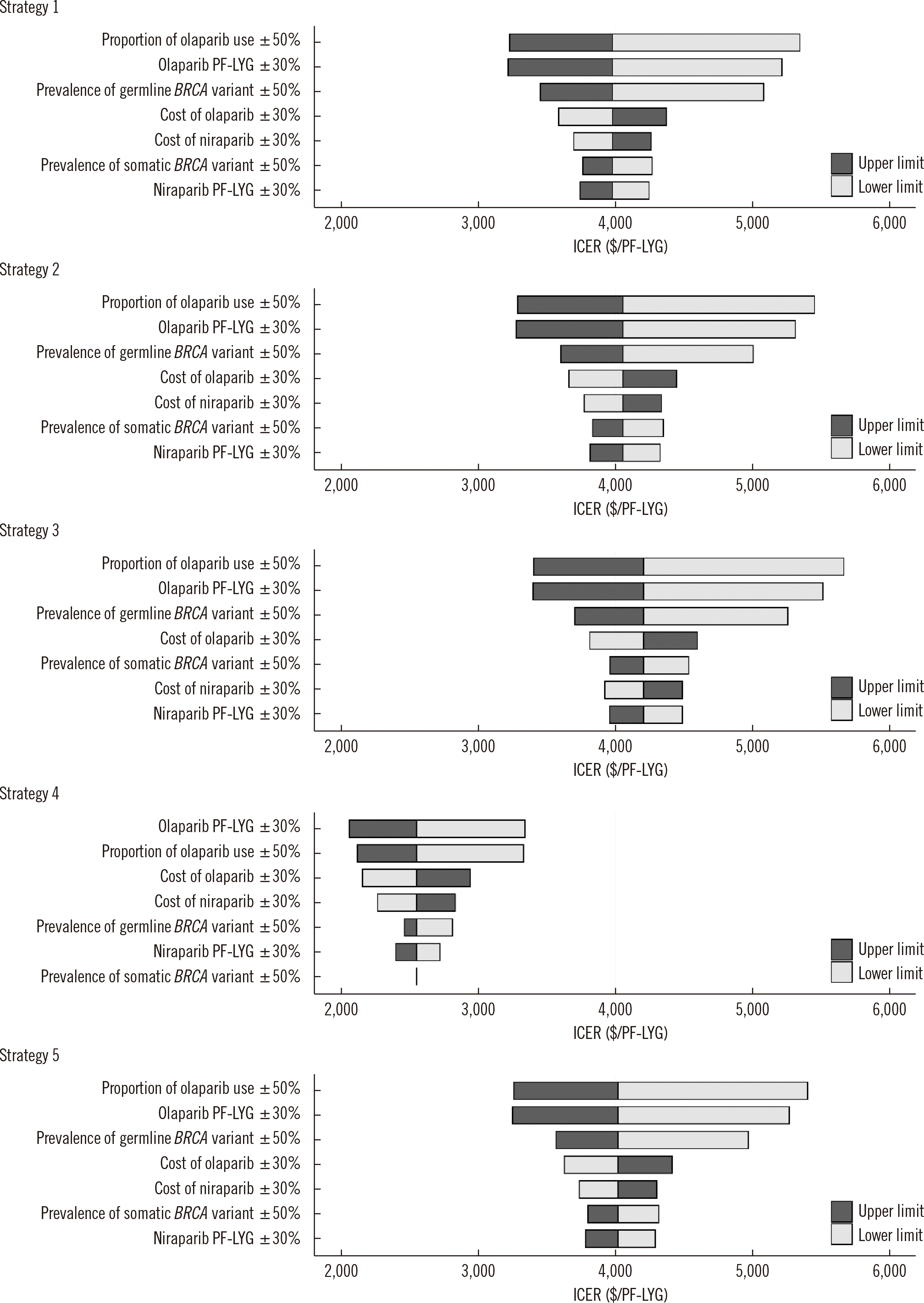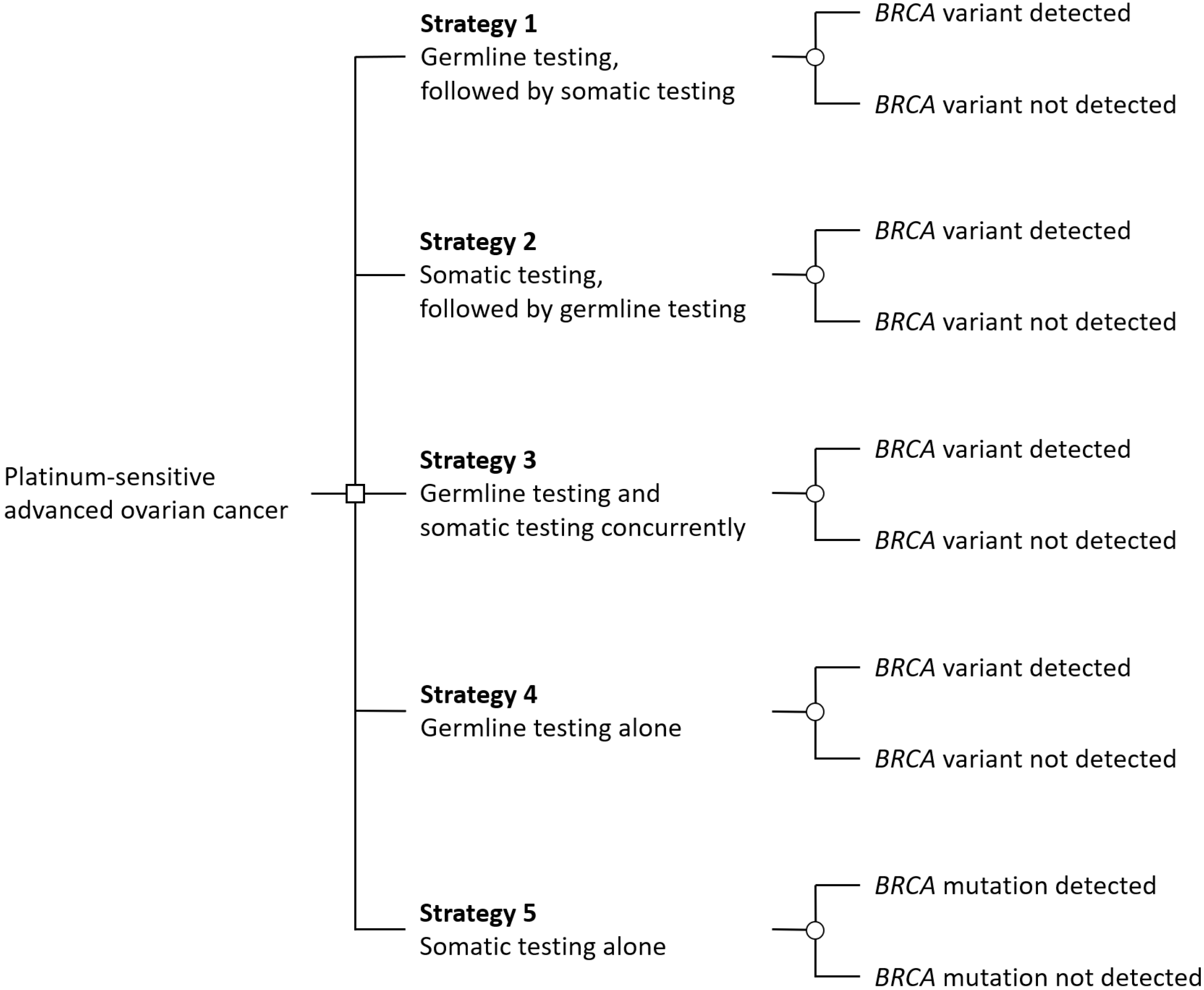1. Daly MB, Pal T, Berry MP, Buys SS, Dickson P, Domchek SM, et al. 2021; Genetic/familial high-risk assessment: breast, ovarian, and pancreatic, version 2.2021, NCCN Clinical Practice Guidelines in Oncology. J Natl Compr Canc Netw. 19:77–102. DOI:
10.6004/jnccn.2021.0001. PMID:
33406487.

2. Konstantinopoulos PA, Norquist B, Lacchetti C, Armstrong D, Grisham RN, Goodfellow PJ, et al. 2020; Germline and somatic tumor testing in epithelial ovarian cancer: ASCO guideline. J Clin Oncol. 38:1222–45. DOI:
10.1200/JCO.19.02960. PMID:
31986064. PMCID:
PMC8842911.

3. Armstrong DK, Alvarez RD, Bakkum-Gamez JN, Barroilhet L, Behbakht K, Berchuck A, et al. 2021; Ovarian cancer, version 2.2020, NCCN Clinical Practice Guidelines in Oncology. J Natl Compr Canc Netw. 19:191–226. DOI:
10.6004/jnccn.2021.0007. PMID:
33545690.

4. Owens DK, Davidson KW, Krist AH, Barry MJ, Cabana M, et al. US Preventive Services Task Force. 2019; Risk assessment, genetic counseling, and genetic testing for
BRCA-related cancer: US Preventive Services Task Force recommendation statement. JAMA. 322:652–65. DOI:
10.1001/jama.2019.10987. PMID:
31429903.

5. Fong PC, Boss DS, Yap TA, Tutt A, Wu P, Mergui-Roelvink M, et al. 2009; Inhibition of poly(ADP-ribose) polymerase in tumors from
BRCA mutation carriers. N Engl J Med. 361:123–34. DOI:
10.1056/NEJMoa0900212. PMID:
19553641.

6. Moore K, Colombo N, Scambia G, Kim BG, Oaknin A, Friedlander M, et al. 2018; Maintenance olaparib in patients with newly diagnosed advanced ovarian cancer. N Engl J Med. 379:2495–505. DOI:
10.1056/NEJMoa1810858. PMID:
30345884.

7. Banerjee S, Moore KN, Colombo N, Scambia G, Kim BG, Oaknin A, et al. 2020; Maintenance olaparib for patients (pts) with newly diagnosed, advanced ovarian cancer (OC) and a
BRCA mutation (
BRCAm): 5-year (y) follow-up (f/u) from SOLO1. Ann Oncol. 31:S613. DOI:
10.1016/j.annonc.2020.08.950.
8. González-Martín A, Pothuri B, Vergote I, DePont Christensen R, Graybill W, Mirza MR, et al. 2019; Niraparib in patients with newly diagnosed advanced ovarian cancer. N Engl J Med. 381:2391–402. DOI:
10.1056/NEJMoa1910962. PMID:
31562799.

9. Korea Central Cancer Registry National Cancer Center. Annual report of cancer statistics in Korea in 2018. Ministry of Health and Welfare;2020.
10. Alsop K, Fereday S, Meldrum C, deFazio A, Emmanuel C, George J, et al. 2012; BRCA mutation frequency and patterns of treatment response in
BRCA mutation-positive women with ovarian cancer: a report from the Australian Ovarian Cancer Study Group. J Clin Oncol. 30:2654–63. DOI:
10.1200/JCO.2011.39.8545. PMID:
22711857. PMCID:
PMC3413277.
12. Pennington KP, Walsh T, Harrell MI, Lee MK, Pennil CC, Rendi MH, et al. 2014; Germline and somatic mutations in homologous recombination genes predict platinum response and survival in ovarian, fallopian tube, and peritoneal carcinomas. Clin Cancer Res. 20:764–75. DOI:
10.1158/1078-0432.CCR-13-2287. PMID:
24240112. PMCID:
PMC3944197.

13. Cunningham JM, Cicek MS, Larson NB, Davila J, Wang C, Larson MC, et al. 2014; Clinical characteristics of ovarian cancer classified by
BRCA1,
BRCA2, and
RAD51C status. Sci Rep. 4:4026. DOI:
10.1038/srep04026. PMID:
24504028. PMCID:
PMC4168524.
14. Yoo J, Lee GD, Kim JH, Lee SN, Chae H, Han E, et al. 2020; Clinical validity of next-generation sequencing multi-gene panel testing for detecting pathogenic variants in patients with hereditary breast-ovarian cancer syndrome. Ann Lab Med. 40:148–54. DOI:
10.3343/alm.2020.40.2.148. PMID:
31650731. PMCID:
PMC6822011.

16. World Health Organization. 2015; Regional Office for the Western Pacific. Republic of Korea health system review: WHO Regional Office for the Western Pacific. xviii:102.
17. Muennig P, Bounthavong M. 2016. Cost-effectiveness analysis in health: a practical approach. 3rd ed. Jossey-Bass;p. 199–222.
18. Song HJ, Lee EK. 2018; Evaluation of willingness to pay per quality-adjusted life year for a cure: A contingent valuation method using a scenario-based survey. Medicine (Baltimore). 97:e12453. DOI:
10.1097/MD.0000000000012453. PMID:
30235732. PMCID:
PMC6160178.
19. Moya-Alarcón C, González-Domínguez A, Simon S, Pérez-Román I, González-Martín A, Bayo-Lozano E, et al. 2019; Cost-utility analysis of germline
BRCA1/2 testing in women with high-grade epithelial ovarian cancer in Spain. Clin Transl Oncol. 21:1076–84. DOI:
10.1007/s12094-018-02026-2. PMID:
30617925.

20. Eccleston A, Bentley A, Dyer M, Strydom A, Vereecken W, George A, et al. 2017; A cost-effectiveness evaluation of germline
BRCA1 and
BRCA2 testing in UK women with ovarian cancer. Value Health. 20:567–76. DOI:
10.1016/j.jval.2017.01.004. PMID:
28407998. PMCID:
PMC5406158.
21. Kwon JS, Tinker AV, Hanley GE, Pansegrau G, Sun S, Carey MS, et al. 2019;
BRCA mutation testing for first-degree relatives of women with high-grade serous ovarian cancer. Gynecol Oncol. 152:459–64. DOI:
10.1016/j.ygyno.2018.10.014. PMID:
30876489.
22. Zhong L, Tran AT, Tomasino T, Nugent E, Smith JA. 2018; Cost-effectiveness of niraparib and olaparib as maintenance therapy for patients with platinum-sensitive recurrent ovarian cancer. J Manag Care Spec Pharm. 24:1219–28. DOI:
10.18553/jmcp.2018.24.12.1219. PMID:
30479195.

23. Gonzalez R, Havrilesky LJ, Myers ER, Secord AA, Dottino JA, Berchuck A, et al. 2020; Cost-effectiveness analysis comparing 'PARP inhibitors-for-all' to the biomarker-directed use of PARP inhibitor maintenance therapy for newly diagnosed advanced stage ovarian cancer. Gynecol Oncol. 159:483–90. DOI:
10.1016/j.ygyno.2020.08.003. PMID:
32863036. PMCID:
PMC8086124.

24. Penn CA, Wong MS, Walsh CS. 2020; Cost-effectiveness of maintenance therapy based on molecular classification following treatment of primary epithelial ovarian cancer in the United States. JAMA Netw Open. 3:e2028620. DOI:
10.1001/jamanetworkopen.2020.28620. PMID:
33295974. PMCID:
PMC7726632.

25. Muston D, Hettle R, Monberg M, McLaurin KK, Gao W, Swallow E, et al. 2020; Cost-effectiveness of olaparib as a maintenance treatment for women with newly diagnosed advanced ovarian cancer and
BRCA1/2 mutations in the United States. Gynecol Oncol. 159:491–7. DOI:
10.1016/j.ygyno.2020.08.013. PMID:
32951894.
26. Tan DS, Chan JJ, Hettle R, Ghosh W, Viswambaram A, Yu CC. 2021; Cost-effectiveness of olaparib versus routine surveillance in the maintenance setting for patients with
BRCA-mutated advanced ovarian cancer after response to first-line platinum-based chemotherapy in Singapore. J Gynecol Oncol. 32:e27. DOI:
10.3802/jgo.2021.32.e27. PMID:
33559410. PMCID:
PMC7930440.

27. Vos JR, Fakkert IE, de Hullu JA, van Altena AM, Sie AS, Ouchene H, et al. 2020; Universal tumor DNA
BRCA1/2 testing of ovarian cancer: prescreening PARPi treatment and genetic predisposition. J Natl Cancer Inst. 112:161–9. DOI:
10.1093/jnci/djz080. PMID:
31076742. PMCID:
PMC7019087.
28. Mafficini A, Simbolo M, Parisi A, Rusev B, Luchini C, Cataldo I, et al. 2016;
BRCA somatic and germline mutation detection in paraffin embedded ovarian cancers by next-generation sequencing. Oncotarget. 7:1076–83. DOI:
10.18632/oncotarget.6834. PMID:
26745875. PMCID:
PMC4811444.

29. de Jonge MM, Ruano D, van Eijk R, van der Stoep N, Nielsen M, Wijnen JT, et al. 2018; Validation and implementation of
BRCA1/2 variant screening in ovarian tumor tissue. J Mol Diagn. 20:600–11. DOI:
10.1016/j.jmoldx.2018.05.005. PMID:
29936257.
30. Fumagalli C, Tomao F, Betella I, Rappa A, Calvello M, Bonanni B, et al. 2019; Tumor
BRCA test for patients with epithelial ovarian cancer: the role of molecular pathology in the era of PARP inhibitor therapy. Cancers. 11:1641. DOI:
10.3390/cancers11111641. PMID:
31653094. PMCID:
PMC6896171.

31. Rivera D, Paudice M, Gismondi V, Anselmi G, Vellone VG, Varesco L, et al. 2021; Implementing NGS-based
BRCA tumour tissue testing in FFPE ovarian carcinoma specimens: hints from a real-life experience within the framework of expert recommendations. J Clin Pathol. 74:596–603. DOI:
10.1136/jclinpath-2020-206840. PMID:
32895300.

32. Kofanova O, Bellora C, Garcia Frasquilho S, Antunes L, Hamot G, Mathay C, et al. 2020; Standardization of the preanalytical phase of DNA extraction from fixed tissue for next-generation sequencing analyses. N Biotechnol. 54:52–61. DOI:
10.1016/j.nbt.2019.07.005. PMID:
31398512.

33. Hofreiter M, Jaenicke V, Serre D, von Haeseler A, Pääbo S. 2001; DNA sequences from multiple amplifications reveal artifacts induced by cytosine deamination in ancient DNA. Nucleic Acids Res. 29:4793–9. DOI:
10.1093/nar/29.23.4793. PMID:
11726688. PMCID:
PMC96698.

34. Do H, Dobrovic A. 2012; Dramatic reduction of sequence artefacts from DNA isolated from formalin-fixed cancer biopsies by treatment with uracil-DNA glycosylase. Oncotarget. 3:546–58. DOI:
10.18632/oncotarget.503. PMID:
22643842. PMCID:
PMC3388184.

35. Wong SQ, Li J, Tan AY, Vedururu R, Pang JM, Do H, et al. 2014; Sequence artefacts in a prospective series of formalin-fixed tumours tested for mutations in hotspot regions by massively parallel sequencing. BMC Med Genomics. 7:23. DOI:
10.1186/1755-8794-7-23. PMID:
24885028. PMCID:
PMC4032349.

36. Kim Y, Cho CH, Ha JS, Kim DH, Kwon SY, Oh SC, et al. 2020; An optimized
BRCA1/2 next-generation sequencing for different clinical sample types. J Gynecol Oncol. 31:e9. DOI:
10.3802/jgo.2020.31.e9. PMID:
31788999. PMCID:
PMC6918881.

37. Jung SM, Ryu JM, Park HS, Park JS, Kang E, Lee S, et al. 2020; Trends in risk-reducing mastectomy and risk-reducing salpingo-oophorectomy in Korean carriers of the
BRCA1/2 mutation. J Breast Cancer. 23:647–55. DOI:
10.4048/jbc.2020.23.e61. PMID:
33408890. PMCID:
PMC7779723.






 PDF
PDF Citation
Citation Print
Print




 XML Download
XML Download